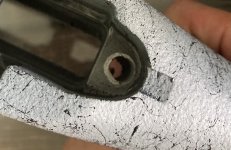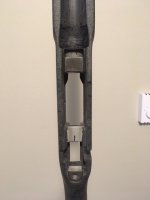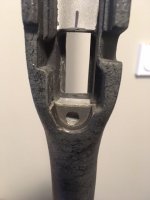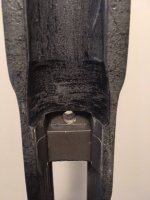Leaving aside whether or not you should bed (I don't believe it's bad to do if done properly, and it's a joy to have a "fit like a glove" between the stock and BA, although it makes resale a pain), I'll try to answer your question.
There are lots of ways to bed, and most of them work just fine, so know that to start. The least intrusive is what's typically called a "skim bed," where you remove little if any material and just use the epoxy to fill in surfaces to make a glove fit. Lots of people do this with no issue, but I tend to be concerned that a little bit of flex could break the bond and flake the stuff out; not saying that concern is valid, just what my mind's eye can envision. I tend to go to the other end of the spectrum and remove a fair amount of material, including some opposing holes that make the epoxy structure impossible to pop out; these holes are usually in the receiver bearing surface aft of the recoil lug, and I drill them maybe 1/4" deep at opposing 45-deg angles, but I'm pretty sure this is overkill. To answer your first question: it's totally up to you, you can just skim bed and remove basically nothing, or hog out substantial amounts of material to leave a good-sized epoxy bed after the job is done. Not sure there's a right answer to this one, just lots of opinions/preferences.
I think your second question, where to leave the elevated surface(s), is much clearer and with far fewer "right" answers. I subscribe to the "stress-free" bedding technique used by Richard's Custom Rifles (link below), and I'd recommend their DVD that shows the whole process to any first-time bedder. In short though, you leave the rear tang contact surface (should be aluminum in that B&C stock) untouched, or at most with the paint removed (very, very carefully). Then you remove enough material around that aluminum surface and everywhere forward of it to ensure no contact anywhere. To set the forward height, you wrap the barrel maybe 2-4" from the end of the stock in electrical tape with just enough layers where it drops snugly into the barrel channel and is centered, with no slop and not "propped up" out of the channel on the two edges on either side. This will ensure the BA is centered left/right, and also addresses any concerns about having to choose where the recoil lug does and doesn't touch. Put two layers of masking tape on the rim of the recoil lug (left/bottom/right edge), as well as the front (muzzle) face, leaving the rear of the lug untaped. I usually also remove material behind the recoil lug to ensure there's enough room for a good epoxy layer there as well. There should be enough clearance before bedding that the only contact points are at the rear tang and the electrical tape. When the bedding sets, you should have full contact at the rear tang (which you can also bed, just to get good fill around that aluminum contact surface and also to set the rearward limit on the action location, plus it just looks nicer), under the front portion of the receiver, and at the rear of the recoil lug, but nowhere else. Some folks like to bed the first inch or two of the barrel as well, and that's fine too; honestly, it's easier to do it that way, since you don't have to remove the excess epoxy in front of the recoil lug recess like you do using my method.
Does that make sense?





